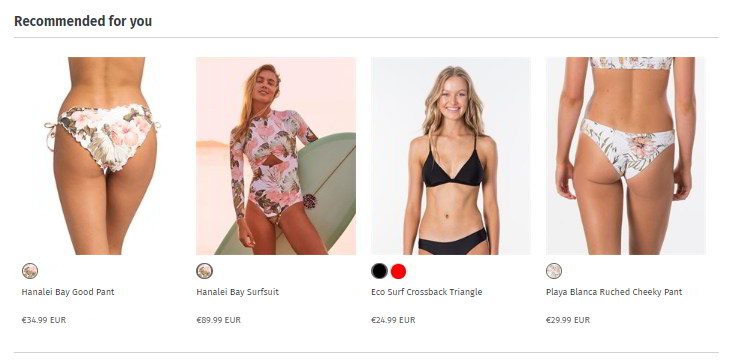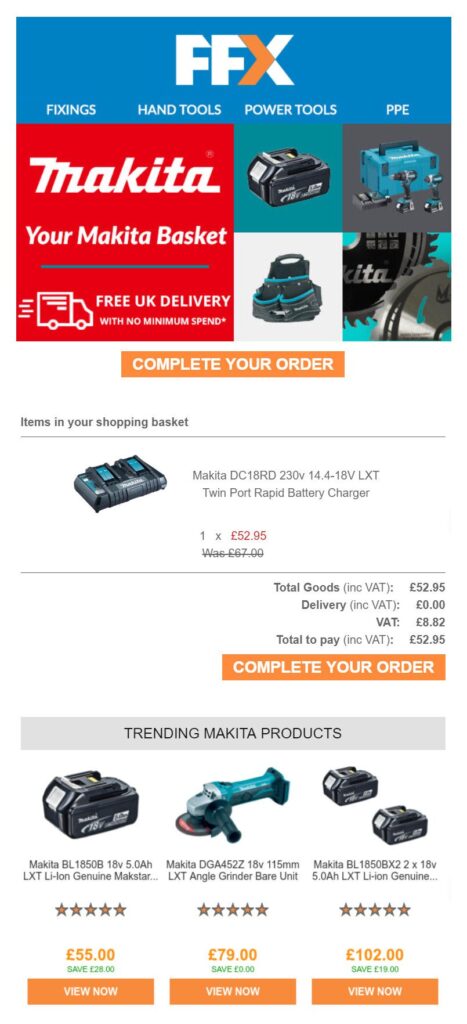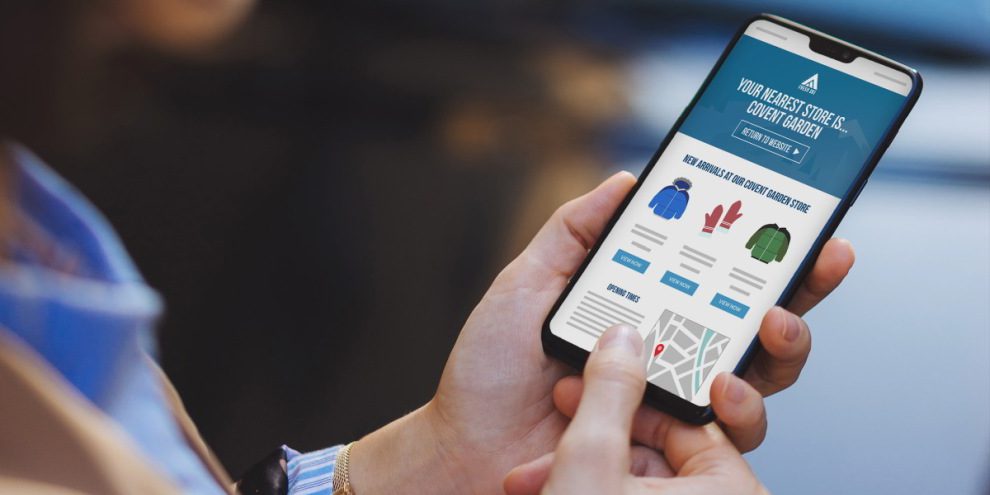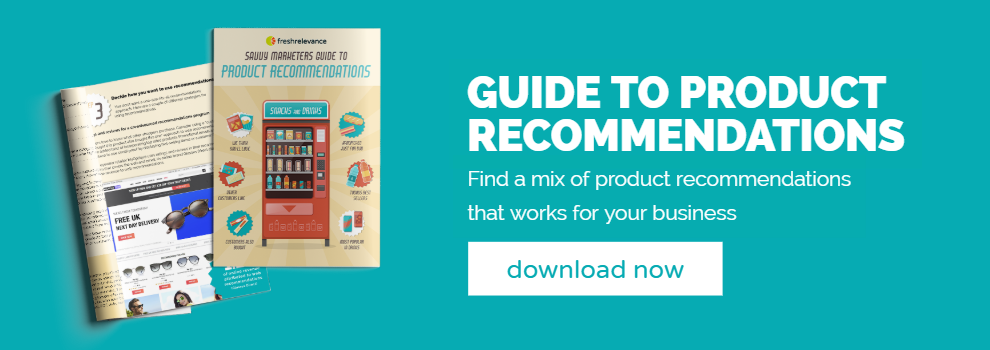If you’re responsible for an eCommerce store, you almost certainly already use some kinds of product recommendations.
But if you’re relying on basic suggestions for related products, you could be missing out on significant revenue.
Here, we’ll explore some product recommendation tactics you might not have thought about. All are designed to drive sales by increasing relevancy and aiding discovery – both on site, and through emails.
Let’s dive right in.
1. Mixing and matching recommendations
Often, the smartest approach is to mix and match different recommendation types.
For instance, when a known visitor returns to your homepage, you want to make their shopping journey easier. They may be looking for new products, or simply want to pick up where they left off.
The shopper hasn’t yet clicked through to a category or product page, so you don’t know exactly what they’re looking for. But you can get a good indication of their needs and preferences from their past browsing data, and crowdsourced behavioral data.
Try combining personalized product suggestions with trending products from their favorite category. This way, you can cover products they’ve already seen, and items they might not yet know about. Mixing it up also helps you avoid the perils of over-personalization.
The same logic applies to browse abandonment emails, where you can highlight recently browsed items along with popular alternatives.
International surfing apparel company Rip Curl used this approach on their website and in their cart abandonment emails. “Recommended for you” product recommendations include products that were bought by similar customers, frequently browsed items, and exciting new Rip Curl lines.

We recommend you split test different combinations to find out what resonates with your customers, and use the results to shape future emails and web pages.
Leverage brand loyalty
Online retailers that sell multiple brands can use recommendations to leverage brand preferences.
Why not set up web and email recommendations that automatically feature the brands that a customer likes?
You can also create highly curated web and email messages by specifically eliminating certain brands. This is helpful if you stock different brands that don’t want to be shown on the same web page or same email as their competition.
One of the biggest Dutch online children’s clothing retailers, Kleertjes.com, offers brand-based recommendations. They send branded newsletters, where any customer who buys Tommy Hilfiger, for example, will receive an email with suggestions as soon as the new collection is released. That effort has helped drive 2.1% of their overall gross sales.

FFX Tools sends cart and browse abandonment messages personalized based on shoppers’ brand affinity. This makes sense, as power tool buyers tend to be loyal to certain brands due to compatibility requirements.
For example, a shopper who carted a Makita power tool is likely to need accessories from the same brand. These customers receive an email with a hero image based on the make of the carted product, and product recommendations from the same manufacturer.

Filter based on real-time information
Whether on your website or in marketing emails, product recommendations have huge potential to drive sales.
You don’t want to waste this valuable real estate on irrelevant or frustrating product suggestions.
Filtering by price
One option is to filter product recommendations based on price. For instance, if some of your customers fall into a ‘bargain hunter’ persona, you could show them recommendations for lower-cost products. This avoids pushing shoppers away with suggestions out of their budget.
One-off purchases
It’s a good idea to base product recommendations on a customer’s past browsing and purchase behavior. But there are some instances where it’s not appropriate to recommend an item that someone has already purchased.
For example, some products are inherently one-off purchases.
McKinsey & Co. asked consumers to keep a diary of their personalized interactions with brands, and analyzed what kind of communication worked best.
One shopper reported receiving a product recommendation email after purchasing a puffer jacket.
The problem? The email recommended similar puffer jackets she might like. As the shopper pointed out, most people don’t need more than one puffer jacket!
For products like these, it’s much more useful to exclude recent buys from recommendations. Instead, retailers should focus on items that complement the original purchase.
On some occasions, it makes sense to exclude products that have recently been recommended to the individual. It’s important to strike a balance between the benefits of repeated exposure, and repeating the same ineffective product recommendation over and over.
Take note of returns
It’s also a good idea to consider returned items when building product recommendations.
For example, if a shopper purchases a Hawaiian shirt, this could indicate that they like this kind of pattern. Based on this information, the product recommendations engine may well start suggesting similarly colorful clothing.
But if the customer returned the item because they didn’t like it, these recommendations are unlikely to resonate, and may even annoy the customer. It’s vital to update a customer’s purchase history with the items they returned to ensure subsequent marketing is based on relevant information.
Leverage the customer’s location
Recommendations based on a customer’s behavior are likely to be relevant and helpful.
When you combine this data with location-based targeting, suggestions are even more powerful.
The latest marketing tech makes it possible to match a person’s geolocation to location data about stores and products. This means you can filter product recommendations so that individual customers will only see products available near them – either in their region, or at their closest store.

A retailer with many brick and mortar locations could show products available at the shopper’s nearest outlet. This is a great tactic if your customers like to click-and-collect, or tend to browse online and buy in store. It’s also perfect for specialized products such as job or event listings.
For instance, a leisure website could include product recommendations in a bulk email so that individuals see suggestions for events in their area. A recipient in London receives recommendations for events in South East England, while a recipient in Liverpool sees events in the North West.
There’s no need to waste a recommendation on an event the recipient can’t attend.
Get granular with SKU-level recommendations
Personalized product recommendations – such as frequently browsed products – rely on the familiarity principal and exposure effect. A product you’ve already browsed multiple times is (a) most likely to be something you’re interested in, and (b) likely to get your attention as you’ve seen it before.
Traditional product recommendations focus on generic products. For example, if you’ve recently browsed Shirt X, the default variant of Shirt X will be shown in your recently browsed product recommendations. That means you might see an image of a regular black t-shirt, rather than the blue version that you were really looking at.

It makes sense to treat product variations, or SKUs, as first-class citizens in product recommendations. So if you looked at the blue variant of a shirt, you’ll see the blue product image in your recommendation feed.
This is much more engaging than a generic image that doesn’t represent what customers were looking for.
If you’re keen to get started with product recommendations, download the dedicated ebook to find out more.






